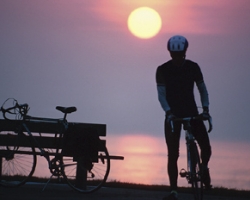Take a comprehensive vision, add a good helping of political will, mix in some inspiration, a few dashes of innovation, stir together and serve. That would seem to be the recipe for success in Long Beach, where they have made major strides in working toward their goal of becoming the most bicycle-friendly urban city in America. Clearly, with Portland, Ore., Boulder, Colo., Chicago Ill. and Marin, Calif. leading the way, they have their work cut out for them.
Recently, representatives from the Culver City Bicycle Coalition joined representatives from Santa Monica and Los Angeles for a city-wide tour of Long Beach to see firsthand the innovative strides they have taken. The goal was to learn how we, too, can achieve the same success they have enjoyed. We came with questions such as: “What makes their program unique? How has it been funded? Has it made a difference? What have been the obstacles and what were the solutions?”
Led by city Mobility Coordinator Charlie Gandy, we rode their new bike boulevard, separated bikeways and neighborhoods that underwent “road diets,” complete with roundabouts, traffic circles and new bike lanes. We visited the soon-to-be-completed downtown bicycle station, bike corrals, and were introduced to their successful “Shop/Dine/Bike Long Beach” program that encourages community cycling while boosting local businesses.
Gandy also outlined their funding strategy, which included, among others, some of the same state and federal funding programs that Culver City is currently pursuing. Long Beach has raised $21 million in grants to help implement its plan (it is important to note the plan was first approved 10 years ago and is now going through an updating process). What has helped the city tremendously though, has been being a first mover, that is, defining themselves as leaders in the urban cycling movement. By adopting a “Living Streets” vision, in which cycling plays but a part in their overall vision of an alternative city, they have set the bar high. Their overall philosophy of economical gardening encourages the city to spend money where their residents live, so the residents will spend their money where they live. This keeps more discretionary spending within their city, helping the entire city grow.
And why all this attention to bicycles? Do they really provide as much good as we would like to believe? Simply put, cycling makes good sense. The act of getting on a bike can have far-reaching effects – not only for our health and environment – but also for our local economy. Bicycling within our communities should be an integral part of local economic development because it encourages us to shop and dine locally, minimizes traffic and parking issues, is cheaper and less of a hassle than driving, increases safety, reduces air pollution, and it’s just plain fun.
What Long Beach has found is that by incorporating good bike infrastructure into the planning policies, the bike system has created more business not more cars. Local businesses have survived – and even thrived – during the economic turndown (at least seven bike shops have opened in the area in the last few years), traffic has been reduced, safety has improved and the city has crafted a new image appealing to younger, family-oriented citizens. They have also been a magnet for a new a string of events and bring a new revenue stream to the city.
But, their progress hasn’t been without obstacles. Some residents couldn’t give a hoot about cycling and were not pleased with some of the improvements. Others were swayed only when they saw that road diets and bike lanes actually increased residential parking. But by sticking to their vision, they have persevered in creating a true bicycle-friendly community that has benefitted the entire city.
With only 10 square miles to cover, a Bicycle Pedestrian Master Plan in place, and the Expo Line coming, Culver City has a unique opportunity to create something special as well. It’s encouraging to have a neighboring city as a role model. I encourage everyone to get out and ride, see the improvements that are being made, make note of what else could be done and join us in helping the city implement its Master Plan. Together we can become a safer, healthier and more vibrant city.
Join the CCBC Saturday, June 25, as they celebrate the grand opening of the Overland Gate. They will lead a family ride to the event and then a family ride down the bike path afterward. Check their site for details.
Bike Safe, Bike Smart! is a weekly column to promote responsible cycling by providing information, education and advice about riding. It’s written by members of the Culver City Bicycle Coalition (CCBC), a local chapter of the Los Angeles County Bicycle Coalition. Join them for their family bike ride the last Sunday of every month. For more information and to submit questions, write: ccbicyclecoalition@gmail.com and visit their blog:ccbike.org.













